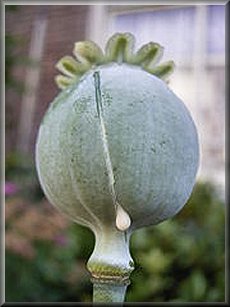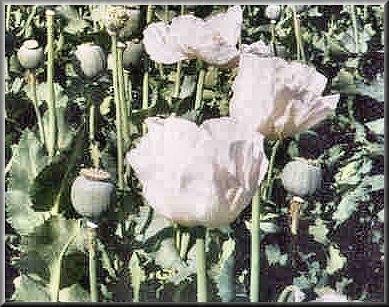Poppy seeds (Opium)



Papaver Somniferum
Poppy seeds:
Poppy seeds contain a large percentage of oil, rich in phosphorus and lecithin, much like sunflower oil, edible, although little used in food, despite its ability to reduce cholesterol in the blood. Opium and poppy are two plants of the family of poppies, characterized by their capacity for synthesis of various alkaloids in the poppy predominates, the Poppy has identified more than 20, mixed in juice white, the opium.
It is a herbaceous plant that lives just over a year, the high is up to 2 m. The stems, holes develop the flower on the end, with white or pink petals, very large. The fruit is a hard capsule, like a small grenade that contains the seeds. The leaves are broad and serrated edges which are very numerous, arise directly from the stem, holding him, without petiole.
Opium: Obtained from the sap of the opium poppy,The opium poppy is native to Asia but is cultivated all over the world today as a garden flower and for medicinal purposes. It is an annual plant that is well known for its flowers that are lilac in the wild but is cultivated in a great variety of colors from white to deep red/purple. The seed pods are scored with a sharp instrument immediately after losing the petals and bleed a latex substance (called Opium) which is collected and dried. This latex is used extensively (legally and illegally) to make morphine and heroin.
Poppies and maize are usually grown in the same field. Maize is planted in April and harvested in August. In September and October the poppy seeds are sown amongst the maize stalks which protect the young seedling. The crop must be weeded several times before harvesting in February or March. A few days after the petals have fallen, the outside of the flower pod is scored with a three-bladed knife. The white sticky sap exudes from the pod and dries on its surface overnight. It oxidises to a brown gum which is scraped off with a broad bladed knife, formed into balls and wrapped in banana or mulberry leaves and buried until collection. Each pod can be tapped several times. The seeds form the most productive flowers are kept for planting next season.
Characteristics of the poppy as a medicinal plant
Seventy-five percent of raw opium consists of ingredients that have no significant biological effects, such as water, sugars, and fatty acids. The remaining 25 percent contains numerous biologically active ingredients that interact with opioid receptors. These agents are termed the opiod alkaloids. Alkaloids are complex organic molecules, many of which have been used in traditional medicine or as poisons. Atropine from the deadly nightshade plant dilates the pupil of the eye, and curare is a skeletal muscle relaxant employed in anesthesia, but both agents have also been used as poisons.
Opium contains at least 20 alkaloids and by some claims as many as 50., many of which are narcotics. Their action on the body varies with the dose: first acts as cardiac and cerebral stimulant, but with increasing dose drowsy and reduces muscle activity, at higher doses lowered heart rate and lung. Opium is the source of a wide variety of drugs given the general name of opiates.
However the principal alkaloids are of major interest are:
- morphine,
- codeine,
- noscapine,
- papaverine, and
- thebaine.
Morphine is the most abundant of the opium alkaloids. It constitutes as much as 15 percent of the plant extract. They are all powerful analgesics, but opium, heroin and morphine are all highly- addictive and tolerance quickly develops so that larger and larger doses are needed. Depression of the higher centres of the brain causes feelings of euphoria in which fear, apprehension and inhibition are reduced, the ego is expanded and there is a general sense of well-being.
- Morphine has been used as a medicine and narcotic for thousands of years. Therapeutically, morphine has three principal uses:
- as an analgesic for the relief of acute and chronic pain, the analgesic properties are morphine’s most important clinical use.
- as a respiratory depressant, and
- as an antidiarrheal agent.
- Codeine is a close chemical relative of morphine, differing in only one chemical group. Once administered, codeine is actually metabolized by enzymatic action, and its actions mimic those of morphine. Codeine is currently the most widely-used opiate in the world, and probably the most commonly used drug overall according to numerous reports by organizations including the World Health Organization and its League of Nations predecessor agency.
- It is one of the most effective orally administered opioid analgesics and has a wide safety margin. Its strength ranges from 8 to 12 percent of morphine in most people; differences in metabolism can change this figure as can other medications, depending on its route of administration.
- While codeine can be directly extracted from opium, its original source, most codeine is synthesized from morphine through the process of O-methylation.
- By 1972, the effects of the Nixon War On Drugs had caused across-the-board shortages of illicit and licit opiates because of a scarcity of natural opium, poppy straw, and other sources of opium alkaloids, and the geopolitical situation was growing difficult for the United States. After a large percentage of the opium and morphine in the US National Stockpile of Strategic & Critical Materials was tapped in order to ease severe shortages of medicinal opiates — the codeine-based antitussives in particular — in late 1973, researchers were tasked with finding a way to synthesize codeine and its derivatives. They quickly succeeded using petroleum or coal tar and a process developed at the United States' National Institutes of Health
- Noscapaine has only minimal therapeutic and narcotic properties. It can be used as a cough suppressant, but has no apparent advantage over other agents.
- Papaverine also has minimal narcotic properties.However, it does have vasodilator (blood vessel relaxant) properties, and because of this property it has been employed for both cognition enhancement and erectile dysfunction.
- Thebaine has no narcotic or therapeutic uses despite its chemical similarity to morphine. It does, however, cause convulsions at high doses. It is also a useful chemical intermediate in the laboratory for production of other opioid compounds.
Applications and use of opium as a home remedy
Today the poppy is cultivated in most countries, under government control, and its use is restricted to the pharmaceutical industry. Its main use is as an analgesic and a narcotic. Some alkaloids such as codeine, have antitussive activity.
Used for treatment of:
- Insomnia (fatigued stupor but no sleep)
- Constipation (lazy bowels, sluggish digestion, infrequent compacted evacuation)
- Urine retention
- Cough (associated with difficulty of breathing and snoring at night)
- Injury
- Shock
- Convulsions (associated with delirium)
- Fever (accompanied by a desire to sleep all the time)
Warning: Opium, morphine and heroin are exceptionally habit forming and recreational use of these drugs is illegal in all but very few countries.
Opiate Effects:
The user may experience a state in between sleep and wakefulness, with vivid, usually pleasant dreams. Other less enjoyable effects may include nausea, sweating, drowsiness, mental and physical impairment, poor concentration, apathy, reduced hunger and lowered sex drive. Some individuals feel depressed, anxious and fearful. The opiates also suppress the activity of the muscles of the intestine, leading to constipation or reduced diarrhoea. With high doses the respiratory centre of the brain is incapacitated, potentially causing respiratory failure and death.
Active ingredients of the poppy
The capsule contains a milky juice (latex) that is the opium. It consists of various alkaloids, morphine and is found in greater numbers. The seeds inside the capsules contain a high concentration of oil, called oil of poppies, which is extracted for industrial use andpharmaceutical use. When the flower begins to wilt and the capsule form, the alkaloids are synthesized quickly to go slowly disappearing, the reverse of what happens to oil seeds, whose concentration is always increasing.
The narcotic and sleep-producing properties of opium have been known for thousands of years. The Sumerians in 500 BC were the first to record its use. The Greeks used it extensively. Hippocrates noted its effects and the Roman physician Galen was enthusiastic about its therapeutic properties. The Arabs introduced it to Persia, China and India in the early middle ages. In Europe, Paracelsus discovered laudenum, tincture of opium. Later paragoric, camphor combined with laudenum, was used to control diarrhoea. For 200 years opium was regarded as a universal panacea. Until this century it was the only effective painkiller known to western medicine, when its addictive dangers were not appreciated.
